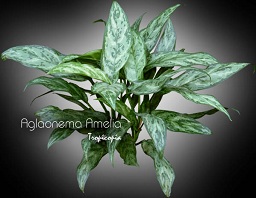Table of contents
Chinese Evergreen

Latin Name: Aglaonema ‘Amelia’
Category: Aglaonema
Family: Araceae
Origin: Hybrid
Climate: Tropical
Growing Zones: 11
Care Instructions
The Chinese Evergreen (Aglaonema ‘Amelia’) is a tropical plant that originates from Hybrid. This aglaonema plant belongs to the Araceae family and is well-suited for growing in USDA zones 11.
Complete Care Guide for Chinese Evergreen (Aglaonema ‘Amelia’)
Watering Requirements
The Chinese Evergreen, particularly the Aglaonema ‘Amelia’, thrives with moderate watering. It is essential to allow the top inch of soil to dry out between waterings to prevent root rot, which is a common issue with this plant. During the growing season, typically spring and summer, water the plant more frequently, about once a week, ensuring that excess water drains out of the pot. In the fall and winter months, reduce watering to every two weeks, as the plant’s growth slows down. Always check the moisture level by sticking your finger into the soil; if it feels dry, it’s time to water. Remember, overwatering is more detrimental than underwatering, so err on the side of caution.
Light Conditions
Chinese Evergreens prefer bright, indirect light but can also tolerate low-light conditions, making them ideal for indoor environments. Direct sunlight can scorch their leaves, leading to unsightly brown patches. For optimal growth, place your Aglaonema ‘Amelia’ near a window with filtered light or in a well-lit room. If you notice the plant becoming leggy or the leaves losing their vibrant color, it may be a sign that it needs more light. Conversely, if the leaves start to yellow, it could be receiving too much direct sunlight. Adjusting its position based on these signs will help maintain its health and beauty.
Soil Preferences
The ideal soil for Aglaonema ‘Amelia’ is a well-draining potting mix that retains some moisture without becoming soggy. A blend of peat moss, perlite, and pine bark works well, providing the necessary aeration and drainage. It’s crucial to ensure that the pot has drainage holes to prevent water from accumulating at the bottom. Fertilization should be done during the growing season with a balanced, water-soluble fertilizer every 4-6 weeks. In the fall and winter, reduce or eliminate fertilization as the plant enters a dormant phase. This practice will help maintain soil health and provide the nutrients necessary for robust growth.
Pests and Diseases
Chinese Evergreens are generally resilient but can be susceptible to pests such as spider mites, aphids, and mealybugs. Regularly inspect the leaves for any signs of infestation, such as webbing or sticky residue. If you notice pests, treat the plant with insecticidal soap or neem oil, ensuring to cover both the tops and undersides of the leaves. Additionally, keep an eye out for fungal diseases, which can occur if the plant is overwatered or in overly humid conditions. Signs of fungal issues include yellowing leaves and a musty smell. To combat this, improve air circulation around the plant and avoid overhead watering. If necessary, remove affected leaves and apply a fungicide as a preventive measure.
Special Care Tips
To keep your Aglaonema ‘Amelia’ thriving, consider the following special care tips: First, regularly wipe the leaves with a damp cloth to remove dust, which can hinder photosynthesis. This also helps to keep the plant looking vibrant and healthy. Additionally, rotate the pot every few weeks to ensure even growth, as plants tend to lean towards their light source. If you notice the plant becoming too large for its pot, repot it in a slightly larger container with fresh soil to promote continued growth. Lastly, be mindful of the temperature; Chinese Evergreens prefer temperatures between 65°F and 80°F (18°C to 27°C) and should be protected from cold drafts and sudden temperature changes. Following these tips will help you maintain a lush and beautiful Chinese Evergreen in your home.








